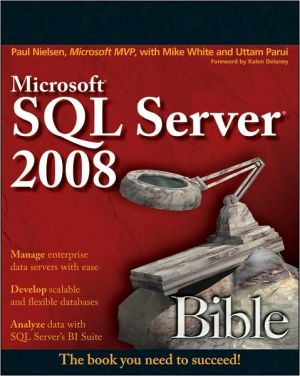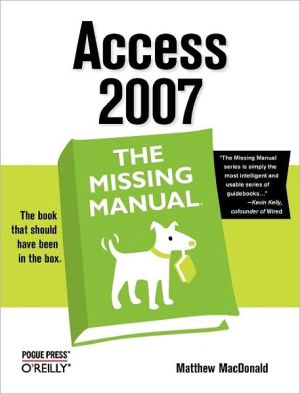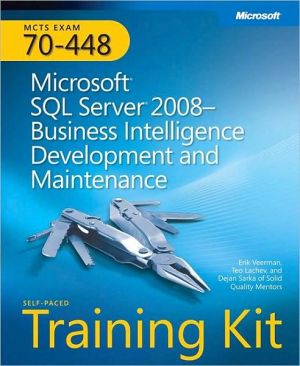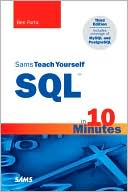Microsoft SQL Server 2008 Bible
Harness the power of SQL Server, Microsoft’s high-performance database and data analysis software package, by accesing everything you need to know in Microsoft SQL Server 2008 Bible. Learn the best practices, tips, and tricks from this comprehensive tutorial and reference, which includes specific examples and sample code, with nearly every task demonstrated in both a graphical and SQL code method. Understand how to develop SQL Server databases and data connections, how to administer the SQL...
Search in google:
"Paul Nielsen brings his passion for SQL Server and his long years of experience with this product into every page of the SQL Server 2008 Bible."—Kalen Delaney, SQL Server MVP Get ready for SQL Server 2008 Whether you're a database developer, DBA, or BI Developer, SQL Server 2008 promises to change the way you deliver enterprise data solutions. Open this detailed, experience-based guide for clear explanations of the concepts balanced with real-world examples and best practices gleaned from years of field and consulting experience. SQL Server is an immense product — this book is your guide to the strategies and details that matter most. Master the data architecture concepts that drive database technologies Write elegant set-based queries that respond well to a comprehensive indexing strategy Code an efficient and robust data abstraction layer with stored procedures Learn the best way to connect to SQL Server with ADO or Microsoft Access Use PowerShell and Policy-based Management to better administer your servers Use Analysis Services, MDX, and Excel to analyze data trends Optimize performance with data compression, resource governor, and partitioning Companion Web SitePlease visit www.sqlserverbible.com to download all the sample databases and code, watch screencasts that walk through key features, sign up for the SQL Server Bible eNewsletter, find additional SQL Server utilities and samples, and find out about the authors' seminars and speaking schedules.Manage enterprise data servers with easeDevelop scalable and flexible databasesAnalyze data with SQL Server's BI SuiteThe book you need to succeed!
Foreword. Introduction. Part I Laying the Foundation. Chapter 1: The World of SQL Server. Chapter 2: Data Architecture. Chapter 3: Relational Database Design. Chapter 4: Installing SQL Server 2008. Chapter 5: Client Connectivity. Chapter 6: Using Management Studio. Chapter 7: Scripting with PowerShell. Part II Manipulating Data with Select. Chapter 8: Introducing Basic Query Flow. Chapter 9: Data Types, Expressions, and Scalar Functions. Chapter 10: Merging Data with Joins and Unions. Chapter 11: Including Data with Subqueries and CTEs. Chapter 12: Aggregating Data. Chapter 13: Windowing and Ranking. Chapter 14: Projecting Data Through Views. Chapter 15: Modifying Data. Chapter 16: Modification Obstacles. Part III Beyond Relational. Chapter 17: Traversing Hierarchies. Chapter 18: Manipulating XML Data. Chapter 19: Using Integrated Full-Text Search. Part IV Developing with SQL Server. Chapter 20: Creating the Physical Database Schema. Chapter 21: Programming with T-SQL. Chapter 22: Kill the Cursor! Chapter 23: T-SQL Error Handling. Chapter 24: Developing Stored Procedures. Chapter 25: Building User-Defined Functions. Chapter 26: Creating DML Triggers. Chapter 27: DDL Triggers. Chapter 28: Building Out the Data Abstraction Layer. Chapter 29: Dynamic SQL and Code Generation. Part V Data Connectivity. Chapter 30: Bulk Operations. Chapter 31: Executing Distributed Queries. Chapter 32: Programming with ADO.NET 3.5. Chapter 33: Sync Framework. Chapter 34: LINQ. Chapter 35: Asynchronous Messaging with Service Broker. Chapter 36: Replicating Data. Chapter 37: Performing ETL with Integration Services. Chapter 38: Access as a Front End to SQL Server. Part VI Enterprise Data Management. Chapter 39: Configuring SQL Server. Chapter 40: Policy-Based Management. Chapter 41: Recovery Planning. Chapter 42: Maintaining the Database. Chapter 43: Automating Database Maintenance with SQL Server Agent. Chapter 44: Transferring Databases. Chapter 45: Database Snapshots. Chapter 46: Log Shipping. Chapter 47: Database Mirroring. Chapter 48: Clustering. Part VII Security. Chapter 49: Authenticating Principals. Chapter 50: Authorizing Securables. Chapter 51: Data Cryptography. Chapter 52: Row-Level Security. Part VIII Monitoring and Auditing. Chapter 53: Data Audit Triggers. Chapter 54: Schema Audit Triggers. Chapter 55: Performance Monitor. Chapter 56: Tracing and Profiling. Chapter 57: Wait States. Chapter 58: Extended Events. Chapter 59: Change Tracking. Chapter 60: Change Data Capture. Chapter 61: SQL Audit. Chapter 62: Management Data Warehouse. Part IX Performance Tuning and Optimization. Chapter 63: Interpreting Query Execution Plans. Chapter 64: Indexing Strategies. Chapter 65: Query Plan Reuse. Chapter 66: Managing Transactions, Locking, and Blocking. Chapter 67: Data Compression. Chapter 68: Partitioning. Chapter 69: Resource Governor. Part X Business Intelligence. Chapter 70: BI Design. Chapter 71: Building Multidimensional Cubes with Analysis Services. Chapter 72: Programming MDX Queries. Chapter 73: Authoring Reports with Reporting Services. Chapter 74: Administering Reporting Services. Chapter 75: Analyzing Data with Excel. Chapter 76: Data Mining with Analysis Services. Appendix A: SQL Server 2008 Specifications. Appendix B: Using the Sample Databases. Index.







![SQL Queries for Mere Mortals: A Hands-on Guide to Data Manipulation in SQL [For Mere Mortals Series] SQL Queries for Mere Mortals: A Hands-on Guide to Data Manipulation in SQL [For Mere Mortals Series]](/application/data/covers/44/31/9780321444431.jpg)
